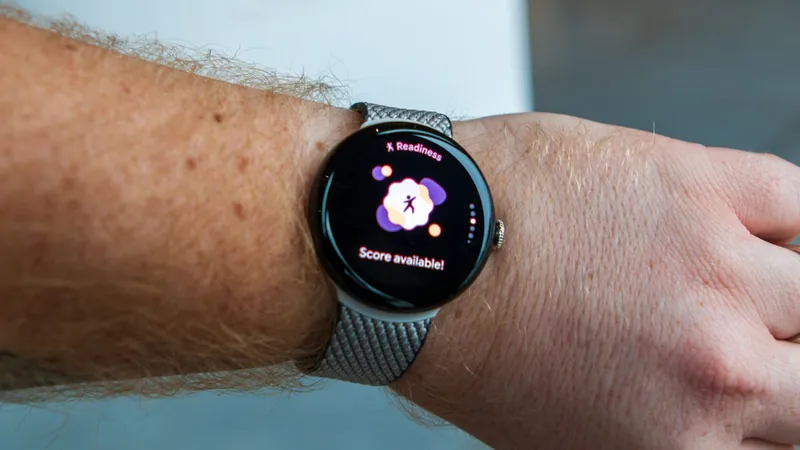
What to Expect from Wear OS Smartwatches in 2025: The Future Looks Bright!
2024-12-29
Author: Jia
What to Expect from Wear OS Smartwatches in 2025: The Future Looks Bright!
As we dive deeper into the celebrations of the holiday season, it’s time to peek ahead and explore what the Wear OS ecosystem has in store for us in 2025. With 2024 marking a significant turning point for Wear OS smartwatches, the anticipation builds for the innovations we can expect next. Here’s a comprehensive look at the hardware and software advancements that could redefine our experience with Android smartwatches.
1. Next-Gen Snapdragon Hardware: A Paradigm Shift
The most significant upgrade on the horizon for Wear OS is likely the introduction of new Snapdragon hardware, possibly the Snapdragon W5 Gen 2. Qualcomm has teased an AI-driven chip that promises to be feature-rich and adaptable, ready to power the next wave of smartwatches for years to come. This upgraded silicon could also leverage RISC-V architecture, heralding a shift towards more energy-efficient, custom chips that could drastically improve battery life and functionality.
Analysts are already expressing excitement over this potential transition, highlighting the implications for longer-lasting devices, with ambitious goals of a week's worth of battery life. While that may still sound far-fetched, it’s a direction that Wear OS desperately needs to maintain competitiveness against rivals like Apple.
2. Google’s Tense Choice: Snapdragon vs. Tensor
There’s speculation surrounding Google’s approach for the Pixel Watch 4, with some leaks indicating a pivot to a Tensor chip instead of the expected Snapdragon variant. This could signify a strategic shift for Google, emphasizing in-house capabilities and machine learning prowess, potentially allowing for innovations that prioritize AI features at the heart of the user experience.
However, with Google's partnership with Samsung crucial to the success of Wear OS, the question remains whether they will continue to innovate alongside or diverge with a completely different chip strategy. Either way, the anticipation builds for how Google will leverage AI to enhance smartwatch functionalities.
3. Focused Health and Fitness Features
Health and fitness tracking will undeniably remain at the forefront of Wear OS development. As competition with major players like Apple and Garmin intensifies, Google aims to integrate more sophisticated health analytics and coaching features into future updates. Wear OS 6 is expected to expand on the existing health metrics, adding dual-band GPS and perhaps introducing innovative tools that could reshape how users interact with their fitness data.
From sleep apnea detection to personalized workout recommendations, Wear OS is positioned to compete aggressively in the health domain. Innovations may also spring forth, such as mental health monitoring features, further widening the allure of smartwatches.
4. Gemini Integration: A Game Changer for Smartwatches
One of the most thrilling prospects for Wear OS in 2025 is the potential integration of Google’s Gemini AI technology. Having been a central theme across Google’s 2024 offerings, Gemini could redefine user interactions on smartwatches if successfully adapted for smaller devices. AI-driven insights and adaptive learning could provide users with contextually relevant information, enhancing productivity and overall user experience.
This integration isn’t without its challenges. The technical hurdles of poor hardware optimization remain, but if resolved, we could see an exponentially smarter ecosystem of wearables that seamlessly connect with other devices.
5. Design Evolution: Samsung’s Departure from Squircles
In terms of design, the Galaxy Watch 8 is expected to maintain a familiar circular aesthetic rather than embracing the controversial squircle shape rumored earlier. Despite internal enthusiasm for a potential design shift, market pressures and consumer sentiment seem to discourage such a bold move. The classic design continuity is likely to cater to user preferences and brand identity while purporting to innovate subtly in functionality.
6. The Return of Facer? A Wish for Customization
Customization enthusiasts may get a glimmer of hope as talks around the revival of Facer stir excitement among Wear OS users. If Google permits a more open approach towards watch face personalization, it could unleash a wave of creativity amongst developers, allowing for a diverse range of unique designs and functionalities.
7. Uncertain Future and New Entrants
As we gaze into the future, the possibility of fresh players entering the Wear OS market could inject new life into the landscape. Motorola, known for its previous forays into Android wearables, could consider re-entering the smartwatch scene, widening consumer options amidst an evolving ecosystem.
However, with concerns about timely updates and potential fragmentation in the software experience, challenges remain. Brands like Mobvoi could face hurdles in compatibility and performance that might overshadow their efforts as they struggle to keep pace with the established titans.
Conclusion: The Future Looks Promising
As we anticipate 2025, the groundwork laid in 2024 will undeniably influence the trajectory of Wear OS. From cutting-edge hardware to AI evolutions and health-centric features, the upcoming years promise an exciting landscape for Android smartwatches. The innovations on the horizon could not only address user demands but also reshape the very concept of wearable technology. So, buckle up, Wear OS enthusiasts – an exhilarating ride awaits!

 Brasil (PT)
Brasil (PT)
 Canada (EN)
Canada (EN)
 Chile (ES)
Chile (ES)
 Česko (CS)
Česko (CS)
 대한민국 (KO)
대한민국 (KO)
 España (ES)
España (ES)
 France (FR)
France (FR)
 Hong Kong (EN)
Hong Kong (EN)
 Italia (IT)
Italia (IT)
 日本 (JA)
日本 (JA)
 Magyarország (HU)
Magyarország (HU)
 Norge (NO)
Norge (NO)
 Polska (PL)
Polska (PL)
 Schweiz (DE)
Schweiz (DE)
 Singapore (EN)
Singapore (EN)
 Sverige (SV)
Sverige (SV)
 Suomi (FI)
Suomi (FI)
 Türkiye (TR)
Türkiye (TR)
 الإمارات العربية المتحدة (AR)
الإمارات العربية المتحدة (AR)